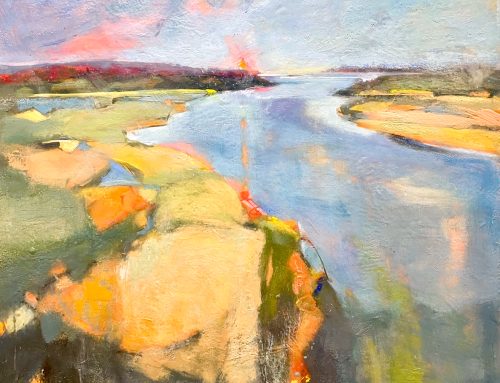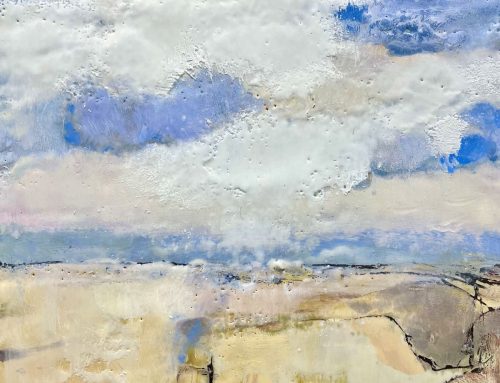When I mention I work in encaustics, I get that puzzled look. My listener usually heard it as, “I work in toxins”. “Toxins?” they say, “Isn’t that dangerous working with toxins?” Then, I explain it’s beeswax and we move on.
WHAT IS ENCAUSTIC? Here’s the scoop in a nutshell. It is simply paint made from a combination of beeswax, resin, and pigment. It is kept molten on a heated palette and applied to a surface and reheated to fuse the paint into a uniform enamel-like finish.
The ancient Greeks developed encaustic over 2,000 years ago. The word encaustic derives from the Greek word “enkaustikos”, meaning “to heat” or “to burn”. Encaustic paints are perhaps the most durable form of painting and keep a permanent lustrous enamel appearance when cared for properly.
Yes, it can be toxic if heated over 200 degrees and the dangerous fumes can fill a studio without proper ventilation. This disaster only happened to me once when I accidentally turned the hot plate to a higher temperature rather than to “off”. Now, I have all my heated tools plugged into a strip that I turn off with a flip of a switch. (Another safety tip: I heat soy wax mixed with essential oil on the hot plate in a small container. If I can smell the essence of lavender, I know I’ve left the plate on.)
Encaustics are an ancient medium, but relatively unfamiliar in most smaller suburban towns, such as western Loudoun County, Virginia, where I live. And that is good and bad for the artist. I feel like a pioneer staking new ground in this art venue heavy with traditional oil paintings and watercolors. However, this community is traditional – a hub of wineries and horse enthusiasts. Something new is well, just new, and to be questioned. So, I try to educate the public about this art medium I truly love and show them what can be done with beeswax and a little creativity — oh yeah, and a lot of heat!
Here’s a sampling of my next show – Western Loudoun Artists Tour (WLAST).
 WLAST is a well-organized, highly popular tour of over 65 local artist studios taking place over the weekend, June 18-19. I’m exhibiting with eight other artists at the Round Hill Art Center stop #29).
WLAST is a well-organized, highly popular tour of over 65 local artist studios taking place over the weekend, June 18-19. I’m exhibiting with eight other artists at the Round Hill Art Center stop #29).
I’ve noted under each piece the wide array of techniques used with the encaustic medium.

Encaustic can be applied to a variety of rigid bases, including tiles. This mixed media piece uses tissue, papers, oil stick, pastels and encaustic to hold it all together. Acrylic medium frustrated me when it came to collage. I felt the embedded objects and layered papers were not secure enough to hold it all together. Wax provides a strong bonding agent and beautiful enamel-like surface when cooled.
Encaustic paints are perhaps the most durable form of painting. The Faiyûm mummy portraits in Egypt have survived over 2000 years! Wax has several inherent qualities that allow it to withstand the test of time: it is a natural adhesive and preservative; it is moisture resistant, mildew and fungus resistant, and unappetizing to insects. Unlike other mediums, encaustic does not contain solvents or oils so they will not darken or yellow with age.

Encaustic is a wonderfully transparent medium for use over photographs. I took this photograph in Maui last winter and added a hymn. Real tree bark is embedded in the wax to represent rocks.

One of my favorite techniques to add visual texture to my paintings is burning shellac over encaustic. The shellac top layer floats on top of the melted wax when burned with a torch and solidifies into spiderweb designs. So cool.

Then, there is always just straight up painting with a brush. Layers and layers of wax give visual dimension and depth. (Tip for beginning encaustic painters: when you’re happy with a layer, coat with clear medium before applying the next. This way it won’t be disturbed when fusing new layers with heat. )

Encaustic can be manipulated with tools, much like clay. Here I’ve scratched in wax to create the sea grass and applied a coat of oil stick over top. Wiping away the oil paint reveals the texture more vividly.
Here are some examples of using a combination of the techniques mentioned above.




I hope this article gave you a new appreciation for encaustic and helped show its versatility. As more artists and art lovers embrace the beautiful diversity of this ancient medium, I bet encaustic will be a regular feature of many local art shows.
If you would like to learn more about encaustic, my events, tutorials, instruction, and latest work for sale; please take a tour of my website. Join me on social media as well by following me on Facebook, Twitter , and Instagram.
You can contact me via email too.
Thanks for visiting.




